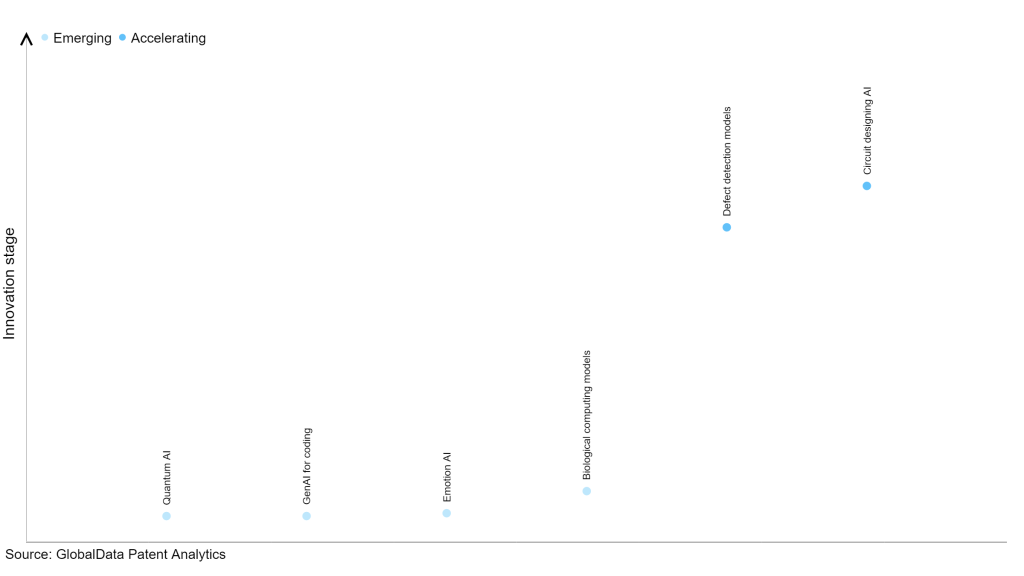The technology industry continues to be a hotbed of patent innovation. Activity is driven by the increasing adoption of smart devices and smart homes, the demand for hands-free and convenient user experiences, and growing integration of voice assistants in various industries such as healthcare, automotive, and customer service, as well as growing importance of technologies such as automatic speech recognition (ASR) to convert spoken language into text, language understanding models to interpret user intent, and dialogue management systems to enable natural and context-aware conversations. Advancements in neural networks, cloud computing infrastructure, and data processing techniques further contribute to the enhanced performance and capabilities of intelligent voice assistants. In the last three years alone, there have been over 1.5 million patents filed and granted in the technology industry, according to GlobalData’s report on Artificial intelligence in technology: intelligent voice assistant. Buy the report here.

Access deeper industry intelligence
Experience unmatched clarity with a single platform that combines unique data, AI, and human expertise.
However, not all innovations are equal and nor do they follow a constant upward trend. Instead, their evolution takes the form of an S-shaped curve that reflects their typical lifecycle from early emergence to accelerating adoption, before finally stabilizing and reaching maturity.
Identifying where a particular innovation is on this journey, especially those that are in the emerging and accelerating stages, is essential for understanding their current level of adoption and the likely future trajectory and impact they will have.
185+ innovations will shape the technology industry
According to GlobalData’s Technology Foresights, which plots the S-curve for the technology industry using innovation intensity models built on over 1.6 million patents, there are 185+ innovation areas that will shape the future of the industry.
Within the emerging innovation stage, quantum AI, GenAI for coding and emotion AI are disruptive technologies that are in the early stages of application and should be tracked closely. Biological computing models, defect detection models, and circuit designing AI are some of the accelerating innovation areas, where adoption has been steadily increasing.
Innovation S-curve for artificial intelligence in the technology industry

Intelligent voice assistant is a key innovation area in artificial intelligence
Intelligent voice assistant refers to a software application with the ability to comprehend voice commands and execute corresponding tasks. It utilises advanced technologies like natural language processing (NLP) and speech recognition to decipher intricate spoken instructions, provide answers to inquiries, and fulfil assigned tasks.
GlobalData’s analysis also uncovers the companies at the forefront of each innovation area and assesses the potential reach and impact of their patenting activity across different applications and geographies. According to GlobalData, there are 1480+ companies, spanning technology vendors, established technology companies, and up-and-coming start-ups engaged in the development and application of intelligent voice assistant.
Key players in intelligent voice assistant – a disruptive innovation in the technology industry
‘Application diversity’ measures the number of applications identified for each patent. It broadly splits companies into either ‘niche’ or ‘diversified’ innovators.
‘Geographic reach’ refers to the number of countries each patent is registered in. It reflects the breadth of geographic application intended, ranging from ‘global’ to ‘local’.
Microsoft is the top patent filer in intelligent voice assistant. The company’s patents are aimed at inventions describing methods and user interfaces for organizing data displayed within a data application. One of the inventions provides methods and systems for arranging the display of the data by a format applied to one or more portions of the data. The formats comprise different visual characteristics of the displayed data.
In exemplary embodiments, the data application organizes the data by the fill color of the cell, the font color of the data within the cell, or the type of icon inserted into the cell. The organizations comprise any type of rearrangement of the data. In exemplary embodiments, the data application sorts or filters the displayed data according to the format.
Other prominent patent filers in the space include International Business Machines (IBM) and Alphabet.
By geographic reach, Deephaven Data Labs leads the pack, followed by People.ai and Cortica. In terms of application diversity, Microsoft holds the top position, followed by Alphabet and International Business Machines.
Intelligent voice assistants have transformed the way users interact with technology, providing personalized and intuitive voice-based interfaces. This innovation involves the integration of artificial intelligence technologies, such as natural language processing (NLP) and machine learning, into voice assistants, enabling them to understand and respond to user queries and commands.
To further understand how artificial intelligence is disrupting the technology industry, access GlobalData’s latest thematic research report on Artificial Intelligence (AI).
Data Insights
From

The gold standard of business intelligence.
Blending expert knowledge with cutting-edge technology, GlobalData’s unrivalled proprietary data will enable you to decode what’s happening in your market. You can make better informed decisions and gain a future-proof advantage over your competitors.







